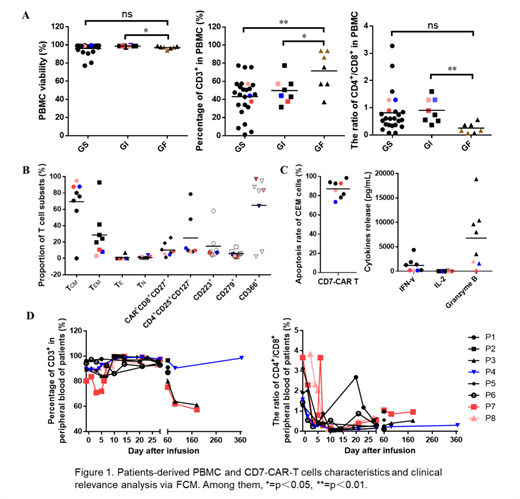Abstract
Background
T cell acute lymphoblastic leukemia and T cell acute lymphoblastic lymphoma (T-ALL/LBL) is a highly aggressive hematological tumor characterized by immature lymphoblasts invading the bone marrow. Treatment options for patients with T-ALL/ LBL are currently limited. Chimeric antigen receptor (CAR)- T cell therapy has opened an era in the treatment of B-cell malignancies. However, the development of CAR-T therapy for T-ALL/LBL faces many challenges. One of them is that therapeutic targets are usually expressed on both tumor and normal T cells, which causes the potential risk of "cell fratricide". Therefore, the difficulty of manufacturing CAR T cells for T-ALL/LBL is dramatically increased. CD7, is 40kD membrane-bound glycoprotein majorly expressed on peripheral T-cells and NK cells and their precursors. CD7 is highly expressed in almost all T-ALL/LBL and considered to be one of the most promising targets for T-ALL/LBL treatment.
Patients and Methods
This study is based on a phase I clinical trial (NCT04004637) for patients with relapse/refractory CD7 + NK/T cell lymphoma and T-ALL/LBL. To manufacture CAR-T cells, the peripheral blood mononuclear cells (PBMC) were collected from the patients who met the enrollment criteria. The proportion of viability and the ratio of the T cell markers were analyzed. Subsequently, the isolated T cells were co-transduced with CD7 protein expression blocker (PEBL) and CD7-CAR lentiviruses to obtain CD7-CAR-T cells, which can avoid the fratricide of CD7-CAR-T cells. Before the infusion, the phenotypic characteristics and cytotoxicity of CD7-CAR-T products were analyzed. Then peripheral blood (PB) of patients was collected regularly after receiving treatment to analyze the immunophenotyping of T cells.
Results
From August 2019 to June 2021, 24 leukopaks from patients with CD7-positive T-ALL/LBL were collected, and a total of 32 batches of CD7-CAR T cells were manufactured, with a 78.13% (25/32) successful rate. Among the 7 batches of failure cases, one patient had undergone blood collection twice and CAR-T preparation for three times, but all of three attempts failed (brown icon). Another four patients failed to prepare once. Eight patents were recruited for CD7-CAR-T treatment and 87.5% of complete remission (CR) rate was achieved (7/8), of which a patient (P4, blue icon) has been maintaining CR for more than 15 months. Two other patients, P7 (red icon) and P8 (light red icon), had CD7 - relapse at the time of 6th month and 3rd month after CR, respectively.
We divided all samples into successful preparation group (GS), infusion group (GI) and preparation failure group (GF). As shown in Fig. 1A, all three groups exhibited good viability of PBMC. There was no significant difference between GS and GF, but GI was higher than that of GF. The proportion of CD3 + cells in PBMC of GS was significantly lower than that of GF, and GI also showed this feature. Meanwhile, GS and GI both have a higher CD4 +/CD8 + ratio compared with GF.
The immunophenotyping results showed CD7-CAR-T products had a majority of the central memory subsets (T CM; 69.41 ± 10.71%) and effect memory subsets (T EM; 28.56 ± 10.19%), with limited number of effector T cell (T E) and naive T cells (T N) (Fig. 1B). The percentage of CAR +CD8 +CD27 + and CD4 +CD25 +CD127 - subsets associated with T cells activation and proliferation, as well as CD223 + and CD279 + subsets related to T cells suppression and exhaustion were lower, except for CD366 + subgroup that also indicated depletion signal (Fig. 1B). In addition, CD7-CAR-T cells showed strong cytotoxicity against CEM (CD7 +) tumor cells accompanied by the release of cytokines, in which the level of IL-2 is extremely low (Fig. 1C).
Subsequently, we performed statistics on the proportion of CD3 + and CD4 +/CD8 + cells in the PB of patients after infusion. The proportion of CD3 + cells in the PB of the P4 has been maintained at a high level, and the ratio of CD4 +/CD8 + keeps low (Fig. 1D). P7 showed a significant decrease in the amount of T cells on the 60th day after CAR T infusion, while the ratio of CD4 +/CD8 + showed an upward trend.
Conclusion
The results indicate that the success rate of CD7-CAR-T manufacturing is positively correlated with higher viability, lower CD3 + and higher CD4 + of PBMC. There was no significant difference among P4 (CR more than 15 months), P7 (CD7 - relapse at 6 th month after CR) and P8 (CD7 - relapse at 3rd month after CR).
No relevant conflicts of interest to declare.


This feature is available to Subscribers Only
Sign In or Create an Account Close Modal